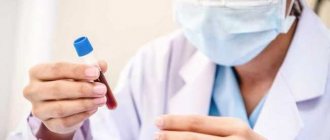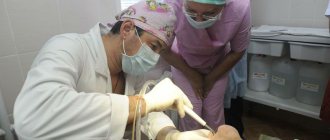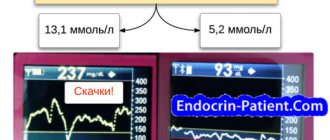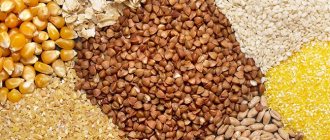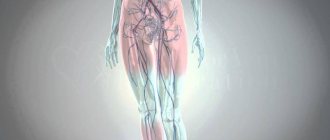General information
Carbohydrate metabolism largely determines the general state of metabolism . Carbohydrates take part in almost all types of metabolism: proteins (glycoproteins), nucleic acids (ribose/deoxyribose), lipids (glycolipids), nucleotides (ATP, AMP, ADP), nucleosides (adenosine), ions. Simple and complex carbohydrates are one of the main sources of energy that ensure the vital functions of the body and are an essential component of the diet. Disorders of carbohydrate metabolism are combined into several typical forms (groups) of pathology: hypo- and hyperglycemia , aglycogenoses , glycogenoses , hexoses and pentosemias .
Hyperglycemia is a clinical symptom characterized by an increase in blood glucose (in plasma) of more than 6.5 mmol/L on an empty stomach and more than 8.9 mmol/L at any time of the day). ICD-10 hyperglycemia code: R73.9 - Hyperglycemia, unspecified. Based on the glucose level (GLU), a mild state of 6.7-11.1 is distinguished. It is characterized by a significant and persistent increase in BPC to a level of 10.5-11.0 mmol/l and is combined with a disorder of the body’s vital functions. This kind of hyperglycemia is defined as hyperglycemic syndrome. The most severe manifestation is a hyperglycemic crisis (GPC > 16.5).
The subject of the article is early disorders of carbohydrate metabolism, which some authors define as “prediabetes”. Early disorders of carbohydrate metabolism usually include the state of impaired glucose tolerance (IGT) and impaired fasting glucose (IFG) or a combination of these conditions (IGT+IGN). It is generally accepted that prediabetes is accompanied by a high risk of developing type 2 diabetes, but in some cases prediabetes does not convert into type 2 diabetes and is assessed by a number of authors as an independent risk factor for the development of cardiovascular diseases. Essentially, these are borderline disorders of carbohydrate metabolism that precede the development of diabetes mellitus , i.e. hyperglycemia with glucose values insufficient for the diagnosis of diabetes.
It has been established that with IGN, liver insulin resistance and hyperproduction of glucose by the liver are more pronounced than with isolated IGT, which is confirmed by higher liver glucose production and the insulin resistance index. IGT is characterized by peripheral insulin resistance, confirmed by lower insulin . In cases of a combination of these conditions (IGT+NGN), the first phase of insulin secretion is disrupted.
According to the literature, the global prevalence of IGT in people aged 30 to 70 years is about 6.7% and continues to increase, and in the Russian Federation, about 19% of the active population have prediabetes, that is, these people are at risk of developing diabetes. Prediabetes, like T2DM, is associated with age and weight gain. Gender differences in the prevalence of early carbohydrate metabolism disorders have not been identified.
According to expert data, the risk of developing type 2 diabetes in people with IGT is 6 times higher than in people with normal glucose tolerance, and in cases of a combination of IGT/NGN, the risk is twelve times higher. The relative risk of overall mortality in persons with IGT is 1.48 times higher than normal, while the risk of cardiovascular complications increases by 1.66 times. In the presence of IFN, the risk of developing T2DM is 4.7 times higher than in persons with normal glucose tolerance. IFN is also associated with a relatively high risk of developing cardiovascular complications.
Thus, active intervention must be carried out already at the prediabetic level of glycemia (stage of NGN and IGT), thereby preventing the development of type 2 diabetes, which is accompanied by various complications in the form of visual impairment, atherosclerosis of the vessels of the heart, lower extremities and brain, nephropathy , and damage to the nervous system.
For this purpose, all individuals need regular screening, which makes it possible to identify IGT, IFN, and type 2 diabetes as early as possible and, accordingly, begin timely treatment, thereby preventing the risk of developing severe complications and potential disability of the patient in the future. For this purpose, the Postprandial Glucose test should be performed regularly, especially in persons at high risk of diabetes, which determines the blood sugar level after a meal (after 2 hours). This test allows you to identify prediabetes at an early stage, when fasting blood glucose levels are still normal. The frequency of self-monitoring of glucose levels is adjusted depending on the needs, specific circumstances and goals of the patient. The emergence of individual glucometers of various types for measuring glycemic levels makes self-monitoring relatively simple and accessible to most interested parties.
of diabetes mellitus, postprandial glucose test indicators are also used to assess the risk of complications from the cardiovascular system ( atherosclerosis , coronary artery disease) in T2DM.
Pathogenesis
The pathogenesis of prediabetes is caused by a qualitative/quantitative deficiency of insulin, which is based on a decrease in insulin activity in adipocytes, muscle tissue and hepatocytes, caused by a deficiency in insulin production by pancreatic β-cells and insulin resistance (decreased sensitivity of receptors to insulin). These disturbances in the post-receptor action of insulin, together with an increasing decrease in insulin production, contribute to an increase in glucose to the corresponding values of NGN (6.1–6.9 mmol/l) and/or IGT (7.8–11.0 mmol/l after OGTT with glucose) . In patients with moderate hyperglycemia, the underlying cause is a decrease in insulin sensitivity of peripheral tissues, mainly muscle tissue. And with hyperglycemia on an empty stomach, an additional negative effect may be an increase in glucose production by the liver.
Causes
The causes of increased blood glucose vary widely, the main ones being:
- Hormonally caused hyperglycemia ( hyperthyroidism , diabetes mellitus , familial polyendocrine adenomatosis , acromegaly , pheochromocytoma , Itsenko-Cushing's disease ).
- Hyperglycemia of central origin (poisoning, brain injury with hemorrhages in the fourth ventricle of the brain, encephalitis , tumors ).
- Psychogenic disorders (stress).
- Diseases of the pancreas ( pancreatitis ), liver failure .
- Extreme prematurity of the child.
- Hyperglycemia against the background of the development of various critical conditions.
- Nutritionally-induced hyperglycemia (eating disorders - bulimia / long-term excess consumption of easily digestible carbohydrates; Prader-Willi syndrome - a predisposition against the background of obesity to the development of insulin-resistant diabetes in childhood; Sipe-Lawrence lipodystrophy - a predisposition to the development of T2DM; Urbach-Wiethe syndrome - a tendency to fasting hyperglycemia).
- Drug-induced hyperglycemia ( glucocorticosteroids , second-generation antipsychotics , stanines , thiazide diuretics , calcineurin inhibitors , etc.).
Risk factors for the development of carbohydrate metabolism disorders include:
- Presence of relationship with patients with T2DM.
- Age 40 years and older with a BMI ≥25 kg/m.
- Low (insufficient) physical activity.
- Persons with arterial hypertension , coronary artery disease.
- Polycystic ovary syndrome.
First aid
While waiting for an ambulance, the patient is given first aid for hyperglycemia. To do this you need:
- Rinse the stomach with a solution of soda in warm water to remove acetone from the body and reduce acidity;
- Wipe the person’s body with a towel soaked in water and wrung out, give a lot of water to drink - these actions replenish the lack of fluid in the body;
- To neutralize high acidity, the patient is given mineral water containing carbonates and sodium, as well as vegetables and fruits.
- Since the condition usually occurs against the background of hormonal diseases and diabetes mellitus in particular, the patient is given a dose of insulin to neutralize glucose in the bloodstream.
- In addition, it is necessary to take a supine position, and then adhere to a low-carbohydrate diet and insulin administration regimen. The patient is advised to have proper rest and sleep. First aid for hyperglycemia helps to avoid not only complications, but also a coma.
Symptoms
A feature of prediabetes is the absence of clear specific clinical symptoms characteristic of diabetes mellitus, which is primarily due to preserved energy supply to tissues and organs and slight glucosuria . In rare cases, symptoms of hyperglycemia at the stage of NGN and IGT manifest in the form of nonspecific patient complaints of increased fatigue, decreased ability to work, and worsening healing of wound defects.
Indirect signs of hyperglycemia at an early stage include:
- obesity or overweight;
- arterial hypertension;
- disorders of the cardiovascular system;
- atherogenic dyslipidemia (increased triglyceride levels and decreased cholesterol levels due to HDL (high-density lipoprotein);
- increased levels of uric acid in the blood ( hyperuricemia );
- fibrinolysis disorder .
On examination, most patients with prediabetes experience an increase in waist circumference to >94 cm in males and >80 cm in females. At the same time, fat mass is distributed predominantly on the torso with its relative decrease in the hips/buttocks area.
Hyperglycemia in children
Carbohydrates play a big role in the development and growth of a child and are an essential and significant component of food. They are involved in almost all types of metabolism: nucleic acids, proteins, lipids, nucleosides. Carbohydrates are essential for optimal functioning, especially brain function. Given the high metabolic rate in children, even minor deviations in carbohydrate metabolism cause disruption of other types of metabolism.
The causes of hyperglycemia in childhood are:
- neurogenic disorders;
- various endocrinopathies;
- liver pathology;
- psychogenic factors;
- binge eating.
In the neonatal period, hyperglycemia is more common and is found in 20-80% of premature babies weighing less than 1500 g. This condition is a prognostically unfavorable sign in this period, which can lead to death. The main cause of hyperglycemia is excessive infusion of glucose solutions during intensive care. An infectious process cannot be ruled out as the cause. Hyperglycemia often occurs in children who have suffered asphyxia and had respiratory disorders. An increase in sugar levels may be a manifestation of transient neonatal diabetes (decreased pancreatic function).
Endocrinopathies are associated with increased activity of hyperglycemic hormones: with an excess of glucagon , the formation of glucose from amino acids and intensive breakdown of glycogen , which is accompanied by an increase in blood sugar. Excess glucocorticosteroids stimulate the formation of glucose, and excess catecholamines stimulate the breakdown of glycogen. With hyperthyroidism, glycogenolysis (the breakdown of glycogen) is enhanced, glycogenesis (the formation of glycogen from glucose, the formation of glucose and its absorption in the intestine are stimulated.
Increased secretion of growth hormone enhances the breakdown of glycogen and inhibits glucose consumption. Neuro- and psychogenic disorders cause activation of the sympathoadrenal system, adrenal glands and the release of thyroid hormones. The hormones of these systems activate the breakdown of glycogen in the liver and the formation of excess glucose.
Overeating (consuming excessive amounts of simple carbohydrates over a long period of time) is considered a cause of hyperglycemia. In this case, glucose is quickly absorbed in the intestines, its level in the blood increases, and the liver is not able to convert it into glycogen in such quantities. When liver function is impaired, transient hyperglycemia always occurs after eating, which is associated with the inability of liver cells to quickly utilize glucose.
Hyperglycemia manifests itself in children as hyperglycemic syndrome and hyperglycemic coma.
Hyperglycemic syndrome includes:
- A persistent increase in sugar levels to 10.5–11.5 mmol/l.
- Detection of sugar in the urine ( glucosuria , which should not be normal).
- Severe, unquenchable thirst ( polydipsia ).
- Polyuria is excessive urination (urine output more than 3 L/day) due to increased glomerular filtration, increased urine osmolality and decreased reabsorption (reabsorption) of water in the tubules.
- Dry skin and signs of dehydration due to polyuria.
- Decreased blood pressure as a result of fluid loss and decreased cardiac output.
- Hyperglycemic (hyperosmolar) coma in children develops with diabetes mellitus due to a lack of insulin. There is an increase in sugar of 22–28 mmol/l or more. Hyperglycemia causes an increase in plasma osmolarity. An increase in osmolarity causes an increase in the permeability of the blood-brain barrier , which causes neurological symptoms. In newborns, increased osmolarity not only depresses the central nervous system and causes cerebral edema , but also causes hemorrhages inside the ventricles of the brain. In newborns with elevated levels of indirect bilirubin, its neurotoxicity increases.
Dysfunction of the central nervous system depends entirely on the level of increase in sugar:
- depression of consciousness;
- tonic-clonic seizures;
- dehydration;
- respiratory failure;
- apnea;
- disorders of the cardiovascular system;
- development of coma .
Mechanisms of development of hyperglycemia and glycosuria in diabetes mellitus
Hyperglycemia: Impaired membrane permeability, impaired synthesis of GL-6-P → glycolysis turns on → glycogen decreases, glycolysis decreases → gluconeogenesis → hyperglycemia. Water reabsorption is impaired → polyuria → dehydration of thirst neurons → polydepsia.
Glucosuria. Normally, glucose is contained in provisional urine. There is no glucose in the final urine, since in the tubules it is completely reabsorbed in the form of glucose phosphate and, after dephosphorylation, enters the blood. In diabetes mellitus, the processes of phosphorylation and dephosphorylation of glucose in the kidney tubules cannot cope with excess glucose in the primary urine. In addition, in diabetes, the activity of hexokinase, which is necessary for the reabsorption of glucose, is reduced. In this regard, the renal threshold for glucose becomes lower than normal. Glucosuria develops. In severe forms of diabetes mellitus, the glucose content in the urine can reach 8-10%. The osmotic pressure of urine is increased, so a lot of water passes into the final urine. Night diuresis is especially increased. In children, one of the early symptoms of diabetes may be bedwetting. As a result of polyuria, dehydration of the body develops and, as a consequence, increased thirst (polydipsia).
Diet
Diet 9th table
- Efficacy: therapeutic effect after 14 days
- Timing: constantly
- Cost of products: 1400 - 1500 rubles per week
Diet for insulin resistance
- Efficacy: therapeutic effect after a month
- Timing: constantly
- Cost of products: 1500-1600 rubles. in Week
Basic principles of nutrition for patients with hyperglycemia include:
- Reducing total calories to 1500 kcal per day.
- Exclusion of simple carbohydrates (sugar, sweets, baked goods, sweet desserts, confectionery, ice cream, jam, condensed milk, sweet drinks).
- Limiting fat intake due to its high calorie content.
- Increasing the amount of protein, as well as fiber up to 30 g/day due to vegetables with a low glycemic index.
The glycemic index reflects the rate at which carbohydrates are broken down into sugar and released into the bloodstream. Products with a high index sharply increase blood sugar levels, and their predominance in the diet will be accompanied by constant hyperglycemia. Patients' diets should be dominated by foods containing fiber, which is digested slowly and does not cause sudden spikes in blood sugar. These can be green vegetables, lettuce, all types of cabbage, unsweetened fruits, legumes, and whole grains.
Vegetables with a high index are excluded or sharply limited: potatoes, carrots, beets, tomatoes. More detailed recommendations can be found in the articles Diet for high blood sugar , Diet 9th table and Diet for insulin resistance .
Symptoms [edit | edit code ]
The following signs may be associated with acute or chronic hyperglycemia, the first three are included in the classic hyperglycemic triad:
- Polydipsia - thirst, especially excessive thirst
- Polyuria - frequent urination
- Weight loss
- Fatigue
- Blurred vision
- Poor wound healing (cuts, scrapes, etc.)
- Dry mouth
- Dry or itchy skin
- Sluggish infections that do not respond well to standard therapy, such as vaginal candidiasis or otitis externa
- Kussmaul's Breath
- Arrhythmia
- Coma
Signs of acute hyperglycemia may include:
- Ketoacidosis
- Impaired consciousness
- Dehydration due to glycosuria and osmotic diuresis
Prevention
- Healthy eating.
- Weight loss and constant weight control.
- Increasing physical activity.
- Identification of high-risk groups (presence of abdominal obesity, heredity of diabetes mellitus, lipid metabolism disorders, high blood pressure, presence of fatty liver, polycystic ovary syndrome) and control of sugar levels in this group.
- Identification of patients with impaired glucose tolerance, fasting glycemia or HbA1C from 5.7-6.4%.
- It is especially important for these patients to follow a diet and increase physical activity.
- Periodic examination by a doctor (once every six months) and decision on the issue of taking metformin if non-drug treatment is ineffective.
Treatment of the disease
Diabetes is a chronic disease, but glucose levels can be kept within normal limits by:
- Moderate physical activity;
- Drink plenty of fluids;
- Adjustments of drug treatment by the attending physician.
One of the most effective ways to maintain a normal glycemic index is diet and control of carbohydrate intake, the so-called “bread unit” . You can consume no more than 25 such units per day, this corresponds to 375 g of carbohydrates.
List of sources
- Demidova T.Yu., Galieva OP Prevention and management of prediabetic disorders of carbohydrate metabolism in patients with metabolic syndrome. “Obesity and Metabolism”, No. 4 (13), 2007; P.19-P.24.
- Nedogoda S.V., Barykina I.N., Salasyuk A.S., Smirnova V.O., Popova E.A. Prediabetes: main causes, symptoms, prevention and treatment//Medicine Bulletin No. 2 (70). 2020. Volume 12.
- Current issues of endocrinology in therapeutic practice: hands. for doctors / Ed. M. N. Kalinkina, L. V. Shpak. - Tver: Factor and K, 2014. - 698 p.
- Pasyeshvili T.M., Koryak V.V. A patient with hyperglycemia at a family doctor’s appointment / Eastern European Journal of Internal and Family Medicine. — 2020.— No. 2.— p. 35-39.
- P.F. Litvitsky, L.D. Maltseva Disorders of carbohydrate metabolism in children: hypoglycemia, hyperglycemia, glycogenosis, aglycogenosis, hexosemia / Issues of modern pediatrics. — 2020.- VOLUME 16/ No. 5 p. 362-368.




